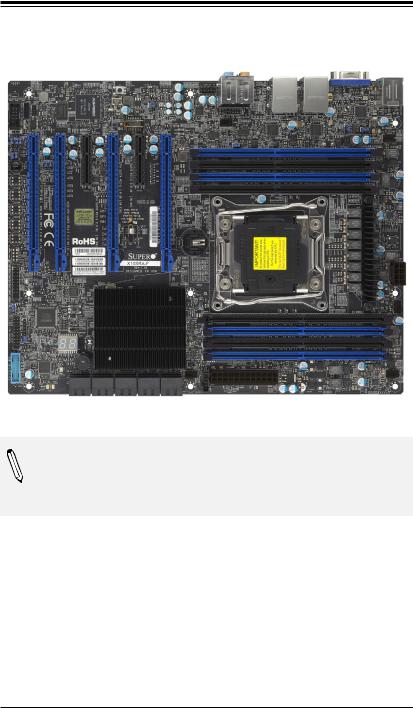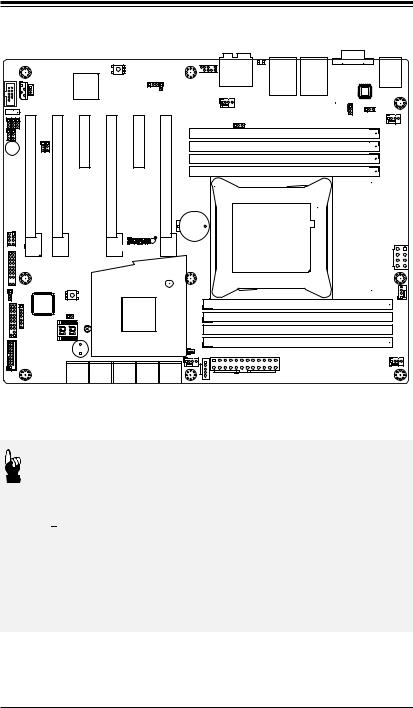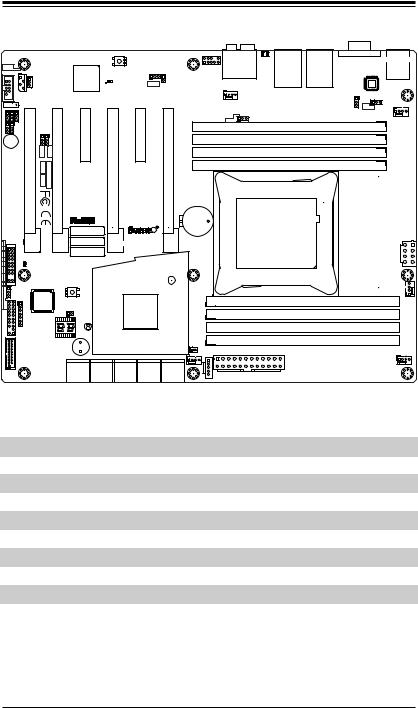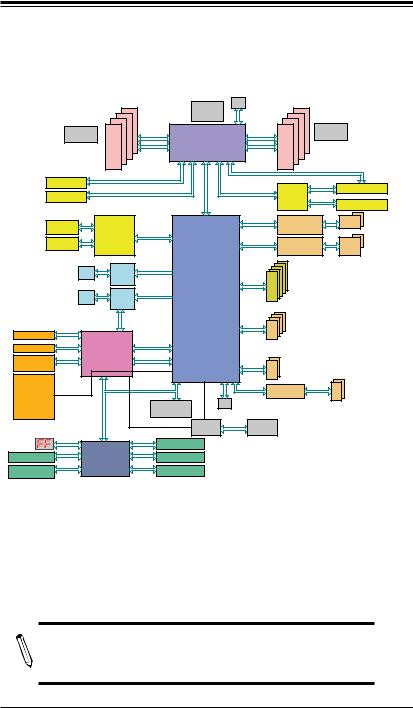Supermicro X10SRA-F Manual

X10SRA
X10SRA-F
USER’S MANUAL
Revision 1.1b

The information in this User’s Manual has been carefully reviewed and is believed to be accurate. The vendor assumes no responsibility for any inaccuracies that may be contained in this document, makes no commitment to update or to keep current the information in this manual, or to notify any person or organization of the updates. Please Note: For the most up-to-date version of this manual, please see our web site at www.supermicro.com.
Super Micro Computer, Inc. ("Supermicro") reserves the right to make changes to the product described in this manual at any time and without notice. This product, including software and documentation, is the property of Supermicro and/or its licensors, and is supplied only under a license. Any use or reproduction of this product is not allowed, except as expressly permitted by the terms of said license.
IN NO EVENT WILL SUPERMICRO BE LIABLE FOR DIRECT, INDIRECT, SPECIAL, INCIDENTAL, SPECULATIVE OR CONSEQUENTIAL DAMAGES ARISING FROM THE USE OR INABILITY TO USE THIS PRODUCT OR DOCUMENTATION, EVEN IF ADVISED OF THE POSSIBILITY OF SUCH DAMAGES. IN PARTICULAR, SUPERMICRO SHALL NOT HAVE LIABILITY FOR ANY HARDWARE, SOFTWARE, OR DATA STORED OR USED WITH THE PRODUCT, INCLUDING THE COSTS OF REPAIRING, REPLACING, INTEGRATING, INSTALLING OR RECOVERING SUCH HARDWARE, SOFTWARE, OR DATA.
Any disputes arising between manufacturer and customer shall be governed by the laws of Santa Clara County in the State of California, USA. The State of California, County of Santa Clara shall be the exclusive venue for the resolution of any such disputes. Super Micro's total liability for all claims will not exceed the price paid for the hardware product.
FCC Statement: This equipment has been tested and found to comply with the limits for a class B digital device, pursuant to Part 15 of the FCC Rules. These limits are designed to provide reasonable protection against harmful interference in a residential installation. This equipment generates, uses, and can radiate radio frequency energy and, if not installed and used in accordance with the instructions, may cause harmful interference to radio communications. However, there is no guarantee that interference will not occur in a particular installation. If this equipment does cause harmful interference to radio or television reception, which can be determined by turning the equipment off and on, the user is encouraged to try to correct the interference by one or more of the following measures:
•Reorient or relocate the receiving antenna.
•Increase the separation between the equipment and receiver.
•Connect the equipment to an outlet on a circuit different from that to which the
•receiver is connected.
Consult the authorized dealer or an experienced radio/TV technician for help.
California Best Management Practices Regulations for Perchlorate Materials: This Perchlorate warning applies only to products containing CR (Manganese Dioxide) Lithium coin cells. “Perchlorate Materialspecial handling may apply. See www.dtsc.ca.gov/hazardouswaste/perchlorate”
WARNING: Handling of lead solder materials used in this product may expose you to lead, a chemical known to the State of California to cause birth defects and other reproductive harm.
Manual Revision 1.1b
Release Date: August 17, 2016
Unless you request and receive written permission from Super Micro Computer, Inc., you may not copy any part of this document.
Information in this document is subject to change without notice. Other products and companies referred to herein are trademarks or registered trademarks of their respective companies or mark holders.
Copyright © 2016 by Super Micro Computer, Inc. All rights reserved.
Printed in the United States of America

Preface
Preface
This manual is written for system integrators, PC technicians and knowledgeable PC users. It provides information for the installation and use of the 




 X10SRA/X10SRA-F motherboard.
X10SRA/X10SRA-F motherboard.
Manual Organization
Chapter 1 describes the features, specifications and performance of the motherboard, and provides detailed information on the Intel C612 Express chipset.
Chapter 2 provides hardware installation instructions. Read this chapter when installing the processor, memory modules and other hardware components into the system.
If you encounter any problems, see Chapter 3, which describes troubleshooting procedures for video, memory and system setup stored in the CMOS.
Chapter 4 includes an introduction to the BIOS, and provides detailed information on running the CMOS Setup utility.
Appendix A provides BIOS Error Beep Codes.
Appendix B lists software program installation instructions. Appendix C contains UEFI BIOS Recovery instructions.
Appendix D contains an introduction and instructions regarding the Dual Boot Block feature of this motherboard.
iii

Supermicro X10SRA/X10SRA-F Motherboard User’s Manual
Checklist
Congratulations on purchasing your computer motherboard from an acknowledged leader in the industry. Supermicro boards are designed with the utmost attention to detail to provide you with the highest standards in quality and performance.
Please check that the following items have all been included with your motherboard. If anything listed here is damaged or missing, contact your retailer.
The following items are included in the retail box.
•
•
•
•
•
One (1) Supermicro Motherboard
Six (6) SATA cables (single packed/boxed only) or,
Two (2) SATA cables (bulk packed only)
One (1) I/O shield
One (1) Quick Reference Guide
Conventions Used in the Manual
Special attention should be given to the following symbols for proper installation and to prevent damage done to the components or injury to yourself:
Attention! Critical information to prevent damage to the components or injury to yourself.
Important: Important information given to ensure proper system installation or to relay safety precautions.
Note: Additional Information given to differentiate various models or provides information for correct system setup.
iv

Standardized Warning Statements
Standardized Warning Statements
The following statements are industry-standard warnings, provided to warn the user of situations which have the potential for bodily injury.
Should you have questions or experience difficulty, contact Supermicro's Technical Support department for assistance. Only certified technicians should attempt to install or configure components.
Read this section in its entirety before installing or configuring components in the Supermicro chassis.
Battery Handling
Warning!
There is a danger of explosion if the battery is replaced incorrectly. Replace the battery only with the same or equivalent type recommended by the manufacturer. Dispose of used batteries according to the manufacturer's instructions
って処分して下さい。
Warnung
Bei Einsetzen einer falschen Batterie besteht Explosionsgefahr. Ersetzen Sie die Batterie nur durch den gleichen oder vom Hersteller empfohlenen Batterietyp. Entsorgen Sie die benutzten Batterien nach den Anweisungen des Herstellers.
Attention
Danger d'explosion si la pile n'est pas remplacée correctement. Ne la remplacer que par une pile de type semblable ou équivalent, recommandée par le fabricant. Jeter les piles usagées conformément aux instructions du fabricant.
v

Supermicro X10SRA/X10SRA-F Motherboard User’s Manual
¡Advertencia!
Existe peligro de explosión si la batería se reemplaza de manera incorrecta. Reemplazar la batería exclusivamente con el mismo tipo o el equivalente recomendado por el fabricante. Desechar las baterías gastadas según las instrucciones del fabricante.
!הרהזא ףילחהל שי .הניקת אל ךרדב הפלחוהו הדימבהללוסה לש ץוציפ תנכס תמייק
ףילחהל שי .הניקת אל ךרדב הפלחוהו הדימבהללוסה לש ץוציפ תנכס תמייק
.תצלמומ ןרצי תרבחמ םאותה גוסב הללוסה תא
.ןרציה תוארוה יפל עצבל שי תושמושמה תוללוסה קוליס
ليلعف ةحيحص ريغ ةقيرطب ةيراطبلا لاذبحسا ةلاح يف راجفنا نم رطخ كانه ةيراطبلا لاذبحسا ةعنصملا ةمرشلا هب ثصوأ امم اهلداعي ام وأ عىنلا سفنب طقف
ةعناصلا ةمرشلا تاميلعحل اقفو ةلمعحسملا تايراطبلا نم صلخج
!
. ..
Waarschuwing
Er is ontploffingsgevaar indien de batterij verkeerd vervangen wordt. Vervang de batterij slechts met hetzelfde of een equivalent type die door de fabrikant aanbevolen wordt. Gebruikte batterijen dienen overeenkomstig fabrieksvoorschriften afgevoerd te worden.
Product Disposal
Warning!
Ultimate disposal of this product should be handled according to all national laws and regulations.
vi

Standardized Warning Statements
Warnung
Die Entsorgung dieses Produkts sollte gemäß allen Bestimmungen und Gesetzen des Landes erfolgen.
¡Advertencia!
Al deshacerse por completo de este producto debe seguir todas las leyes y reglamentos nacionales.
Attention
La mise au rebut ou le recyclage de ce produit sont généralement soumis à des lois et/ou directives de respect de l'environnement. Renseignezvous auprès de l'organisme compétent.
רצומה קוליס
!הרהזא
.הנידמה יקוחותויחנהל םאתהבתויהלבייח הזרצומלש יפוסקוליס
ةينطىلا حئاىللاو نيناىقلا عيمجل اقفو هعم لماعتلا يغبني جتنملا اذه نم يئاهنلا صلختلا دنع
!
.
Waarschuwing
De uiteindelijke verwijdering van dit product dient te geschieden in overeenstemming met alle nationale wetten en reglementen.
vii

Supermicro X10SRA/X10SRA-F Motherboard User’s Manual
Contacting Supermicro
Headquarters
Address: |
Super Micro Computer, Inc. |
|
|
980 Rock Ave. |
|
|
San Jose, CA 95131 U.S.A. |
|
Tel: |
+1 (408) 503-8000 |
|
Fax: |
+1 (408) 503-8008 |
|
Email: |
marketing@supermicro.com (General Information) |
|
|
support@supermicro.com (Technical Support) |
|
Web |
www.supermicro.com |
|
Site: |
||
|
||
Europe |
|
|
Address: |
Super Micro Computer B.V. |
|
|
Het Sterrenbeeld 28, 5215 ML |
|
|
's-Hertogenbosch, The Netherlands |
|
Tel: |
+31 (0) 73-6400390 |
|
Fax: |
+31 (0) 73-6416525 |
|
Email: |
sales@supermicro.nl (General Information) |
|
|
support@supermicro.nl (Technical Support) |
|
|
rma@supermicro.nl (Customer Support) |
|
Asia-Pacific |
|
|
Address: |
Super Micro Computer, Inc. |
|
|
4F, No. 232-1, Liancheng Rd |
|
|
Chung-Ho Dist., New Taipei City 235 |
|
|
Taiwan |
|
Tel: |
+886-(2) 8226-3990 |
|
Fax: |
+886-(2) 8226-3991 |
|
Web |
www.supermicro.com.tw |
|
Site: |
||
|
||
Technical Support: |
||
Email: |
support@supermicro.com.tw |
|
Tel: |
+886-(2)-8226-3990 |
|
viii

Contacting Supermicro
Where to Find More Information
For your system to work properly, please follow the links below to download all necessary drivers/utilities and the user's manual for your motherboard.
SMCI product manuals: http://www.supermicro.com/support/manuals/ Product Drivers and utilities: ftp://ftp.supermicro.com/
If you have any questions, please contact our support team at support@ supermicro.com.
ix

Supermicro X10SRA/X10SRA-F Motherboard User’s Manual
Table of Contents
Preface
Manual Organization........................................................................... |
iii |
|
Checklist........................................................................................... |
iv |
|
Conventions Used in the Manual.......................................................... |
iv |
|
Standardized Warning Statements........................................................ |
v |
|
|
Battery Handling....................................................................... |
v |
|
Product Disposal........................................................................ |
vi |
Contacting Supermicro..................................................................... |
viii |
|
Where to Find More Information.......................................................... |
ix |
|
Chapter 1 |
|
|
Introduction |
|
|
1-1 |
Overview............................................................................... |
1-1 |
|
About this Motherboard........................................................... |
1-1 |
1-2 |
Chipset Overview .................................................................. |
1-1 |
|
Intel C612 Express Chipset Features......................................... |
1-1 |
1-3 Motherboard Features................................................................ |
1-2 |
|
1-4 |
Special Features..................................................................... |
1-4 |
|
Recovery from AC Power Loss.................................................. |
1-4 |
1-5 |
PC Health Monitoring.............................................................. |
1-4 |
|
Fan Status Monitor with Firmware Control ................................ |
1-4 |
|
Environmental Temperature Control.......................................... |
1-4 |
|
System Resource Alert............................................................ |
1-5 |
1-6 |
ACPI Features........................................................................ |
1-5 |
|
Slow Blinking LED for Suspend-State Indicator.......................... |
1-5 |
1-7 |
Power Supply......................................................................... |
1-6 |
1-8 |
Super I/O.............................................................................. |
1-6 |
Chapter 2 |
|
|
Installation |
|
|
2-1 Installation Components and Tools Needed................................ |
2-1 |
|
2-2 |
Static-Sensitive Devices.......................................................... |
2-2 |
|
Precautions............................................................................ |
2-2 |
|
Unpacking............................................................................. |
2-2 |
2-3 Processor and Heatsink Installation.......................................... |
2-3 |
|
|
Installing the Processor .......................................................... |
2-3 |
|
Installing a CPU Heatsink........................................................ |
2-7 |
x
|
Table of Contents |
|
|
|
|
|
|
|
|
Removing a Heatsink.............................................................. |
2-8 |
2-4 |
Installing DDR4 Memory.......................................................... |
2-9 |
|
DIMM Installation................................................................... |
2-9 |
|
Removing Memory Modules..................................................... |
2-9 |
|
Memory Population Guidelines................................................ |
2-10 |
|
Memory Support.................................................................. |
2-10 |
2-5 |
Motherboard Installation........................................................ |
2-13 |
|
Tools Needed....................................................................... |
2-13 |
|
Location of Mounting Holes.................................................... |
2-13 |
|
Installing the Motherboard..................................................... |
2-14 |
2-6 |
Connectors/IO Ports.............................................................. |
2-15 |
|
Back I/O Panel..................................................................... |
2-15 |
|
Universal Serial Bus (USB)................................................. |
2-16 |
|
Ethernet Ports.................................................................. |
2-17 |
|
Back Panel High Definition Audio (HD Audio) ...................... |
2-17 |
|
PS/2 Keyboard/Mouse Port................................................. |
2-18 |
|
VGA Port (X10SRA-F only)................................................. |
2-18 |
|
Front Control Panel............................................................... |
2-19 |
|
Front Control Panel Pin Definitions.......................................... |
2-20 |
|
Power LED ...................................................................... |
2-20 |
|
HDD LED......................................................................... |
2-20 |
|
NIC1/NIC2 (LAN1/LAN2).................................................... |
2-20 |
|
Overheat (OH)/Fan Fail...................................................... |
2-20 |
|
NMI Button...................................................................... |
2-21 |
|
Power Fail........................................................................ |
2-21 |
|
Reset Button ................................................................... |
2-21 |
|
Power Button .................................................................. |
2-21 |
2-7 |
Connecting Cables................................................................ |
2-22 |
|
ATX Main PWR & CPU PWR Connectors (JPW1 & JPW2)......... |
2-22 |
|
Fan Headers (Fan 1 ~ Fan 5)............................................. |
2-23 |
|
Chassis Intrusion (JL1) ..................................................... |
2-23 |
|
Internal Buzzer (SP1)........................................................ |
2-24 |
|
Speaker (JD1).................................................................. |
2-24 |
|
DOM PWR Connector (JSD1).............................................. |
2-25 |
|
Standby Power Header (STBY1).......................................... |
2-25 |
|
System Management Bus (JIPMB1)................................. |
2-25 |
|
TPM Header (JTPM1)......................................................... |
2-26 |
|
Power Supply I2C (JPI2C1)................................................. |
2-26 |
|
Front Panel Audio Header (AUDIO FP)................................. |
2-27 |
|
|
|
xi

Supermicro X10SRA/X10SRA-F Motherboard User’s Manual
2-8 |
Jumper Settings................................................................... |
2-28 |
|
Explanation of Jumpers......................................................... |
2-28 |
|
LAN1/LAN2 Enable/Disable................................................. |
2-28 |
|
Clear CMOS (JBT1, CLR_CMOS_SW, S8).............................. |
2-29 |
|
PCI Slot SMB Enable (I2C1/I2C2)......................................... |
2-29 |
|
Audio Enable (JPAC1)........................................................ |
2-30 |
|
Watch Dog Enable/Disable................................................. |
2-30 |
|
USB Wake-Up (JPUSB1)..................................................... |
2-31 |
|
Manufacturing Mode (JPME2)............................................. |
2-32 |
|
VGA Enable/Disable (JPG1)................................................ |
2-32 |
|
BMC Enable/Disable (JPB1)................................................ |
2-32 |
|
BIOS Recovery Switch (JBR1)............................................ |
2-33 |
|
Power Button (S4)............................................................ |
2-33 |
|
BIOS Restore (S11).......................................................... |
2-33 |
2-9 |
Onboard Indicators................................................................ |
2-34 |
|
LAN 1/LAN 2 LEDs............................................................ |
2-34 |
|
BMC Heartbeat (LEDM1) ................................................... |
2-34 |
|
Power LED (LE2) ............................................................. |
2-35 |
|
Status Display (LED4) ...................................................... |
2-35 |
2-10 |
SATA Connections................................................................. |
2-36 |
|
SATA Connections (I-SATA0~5, S-SATA0~3)........................ |
2-36 |
Chapter 3 |
|
|
Troubleshooting |
|
|
3-1 |
Troubleshooting Procedures..................................................... |
3-1 |
|
Before Power On.................................................................... |
3-1 |
|
No Power.............................................................................. |
3-1 |
|
No Video............................................................................... |
3-2 |
|
Memory Errors ...................................................................... |
3-2 |
|
When the System is Losing the Setup Configuration................... |
3-2 |
3-2 |
Technical Support Procedures................................................... |
3-3 |
3-3 |
Frequently Asked Questions..................................................... |
3-4 |
3-4 Battery Removal and Installation.............................................. |
3-5 |
|
|
Battery Removal..................................................................... |
3-5 |
|
Proper Battery Disposal........................................................... |
3-5 |
3-5 Returning Motherboard for Service........................................... |
3-6 |
|
|
Battery Installation................................................................. |
3-6 |
xii

|
|
Table of Contents |
|
|
|
|
|
|
Chapter 4 |
|
|
BIOS |
|
|
4-1 |
Introduction........................................................................... |
4-1 |
|
Starting BIOS GUI Setup Utility................................................ |
4-1 |
|
How To Change the Configuration Data..................................... |
4-2 |
|
How to Start the Setup Utility.................................................. |
4-2 |
4-2 |
Saving and Loading................................................................ |
4-3 |
|
Save and Load....................................................................... |
4-3 |
|
Restore Defaults................................................................. |
4-4 |
|
Save All Settings Only......................................................... |
4-4 |
|
Save Changes and Exit........................................................ |
4-4 |
|
Save Changes and Reset..................................................... |
4-4 |
|
Discard Changes ................................................................ |
4-4 |
|
Exit without Save............................................................... |
4-4 |
|
Discard Changes and Reset.................................................. |
4-4 |
|
Booting................................................................................. |
4-4 |
4-3 |
System Information................................................................ |
4-6 |
|
Motherboard.......................................................................... |
4-6 |
|
System Date...................................................................... |
4-6 |
|
System Time...................................................................... |
4-6 |
4-4 |
Processor (CPU)..................................................................... |
4-7 |
|
Information........................................................................... |
4-7 |
|
Performance.......................................................................... |
4-8 |
|
Hyper-threading [ALL]......................................................... |
4-8 |
|
Execute-Disable Bit Capability.............................................. |
4-8 |
|
Intel® Virtualization Technology........................................... |
4-8 |
|
Enable SMX........................................................................ |
4-9 |
|
PPIN Control...................................................................... |
4-9 |
|
Hardware Prefetcher........................................................... |
4-9 |
|
Adjacent Cache Line Prefetch............................................... |
4-9 |
|
DCU Streamer Prefetcher..................................................... |
4-9 |
|
DCU IP Prefetcher............................................................... |
4-9 |
|
Direct Cache Access (DCA Support)...................................... |
4-9 |
|
X2APIC.............................................................................. |
4-9 |
|
AES-NI.............................................................................. |
4-9 |
|
Power Management.............................................................. |
4-10 |
|
EIST............................................................................... |
4-10 |
xiii

Supermicro X10SRA/X10SRA-F Motherboard User’s Manual
|
Turbo Mode...................................................................... |
4-10 |
|
P-STATE Coordination........................................................ |
4-11 |
4-5 |
Chipset............................................................................... |
4-12 |
|
System Agent...................................................................... |
4-12 |
|
Intel VT for Directed I/O (VT-d).......................................... |
4-13 |
|
PCH I/O.............................................................................. |
4-14 |
|
Azalia (HD Audio)............................................................. |
4-14 |
|
On Board Chip..................................................................... |
4-15 |
4-6 |
Memory............................................................................... |
4-16 |
|
Memory Information............................................................. |
4-16 |
|
Memory Configuration........................................................... |
4-17 |
4-7 |
Event Logs............................................................................ |
4-18 |
|
SMBIOS Event Log............................................................ |
4-18 |
|
Runtime Error Logging Support.......................................... |
4-18 |
|
Memory Corrected Error Enabling....................................... |
4-19 |
|
Memory Correctable Error Threshold................................... |
4-19 |
|
PCI-Ex (PCI-Express) Error Enable...................................... |
4-19 |
|
Erasing Settings............................................................... |
4-19 |
|
Erase Event Log............................................................... |
4-19 |
|
When Log is Full............................................................... |
4-19 |
|
SMBIOS Event Log Standard Settings.................................. |
4-19 |
|
Log System Boot Event..................................................... |
4-19 |
|
MECI (Multiple Event Count Increment)............................... |
4-19 |
|
METW (Multiple Event Count Time Window)......................... |
4-19 |
4-8 |
Management......................................................................... |
4-20 |
|
ACPI Settings....................................................................... |
4-20 |
|
ACPI Sleep State.............................................................. |
4-20 |
|
High Precision Event Timer................................................ |
4-20 |
|
Console Redirection.............................................................. |
4-21 |
|
COM 1............................................................................. |
4-21 |
|
Enable Console Redirection................................................ |
4-21 |
|
SOL (X10SRA-F only)........................................................ |
4-23 |
|
PCH-FW (Firmware).............................................................. |
4-27 |
4-9 |
IPMI..................................................................................... |
4-28 |
|
IPMI................................................................................... |
4-28 |
|
System Event Log............................................................. |
4-28 |
|
SEL Components.............................................................. |
4-28 |
|
Erasing Settings............................................................... |
4-29 |
|
Erase SEL........................................................................ |
4-29 |
|
|
|
xiv

|
Table of Contents |
|
|
|
|
|
|
|
|
When SEL is Full............................................................... |
4-29 |
|
BMC Network Configuration................................................... |
4-29 |
|
Update IPMI LAN Configuration.......................................... |
4-29 |
|
Configuration Address Source ............................................ |
4-29 |
4-10 Input/Output....................................................................... |
4-31 |
|
|
SATA................................................................................... |
4-31 |
|
SATA Controller................................................................ |
4-31 |
|
Configure SATA as............................................................ |
4-31 |
|
sSATA................................................................................. |
4-33 |
|
sSATA Controller............................................................... |
4-34 |
|
Configure sSATA as........................................................... |
4-34 |
|
PCIe/PCI/PnP....................................................................... |
4-36 |
|
Above 4G Decoding........................................................... |
4-36 |
|
SR-IOV Support................................................................ |
4-36 |
|
PCI PERR/SERR Support.................................................... |
4-36 |
|
CPU SLOT1 PCI-E 3.0 X8 (IN X16) BIFURCATION................. |
4-36 |
|
CPU SLOT6 PCI-E 3.0 X16 BIFURCATION............................. |
4-36 |
|
SLOT2 and SLOT4 Selection............................................... |
4-37 |
|
CPU SLOT1 PCI-E 3.0 X8 (IN X16) - GEN X, |
|
|
CPU SLOT2 PCI-E 3.0 X8 (IN X16) - GEN X, |
|
|
CPU SLOT4 PCI-E 3.0 X8 (IN X16) - GEN X, |
|
|
CPU SLOT6 PCI-E 3.0 X16 - GEN X..................................... |
4-37 |
|
CPU SLOT1 PCI-E 3.0 X8 (IN X16) OPROM, |
|
|
CPU SLOT2 PCI-E 3.0 X8 (IN X16) OPROM, |
|
|
PCH SLOT3 PCI-E 2.0 X1 (IN X4) OPROM, |
|
|
CPU SLOT4 PCI-E 3.0 X8 (IN X16) OPROM, |
|
|
PCH SLOT5 PCI-E 2.0 X1 (IN X4) OPROM, |
|
|
CPU SLOT6 PCI-E 3.0 X16 OPROM...................................... |
4-37 |
|
Video Option ROM Type (X10SRA-F).................................... |
4-37 |
|
Onboard LAN Option ROM Type.......................................... |
4-37 |
|
Onboard LAN1 Option ROM/Onboard LAN2 Option ROM......... |
4-37 |
|
Network Stack.................................................................. |
4-37 |
|
ASPM Support.................................................................. |
4-38 |
|
VGA Priority..................................................................... |
4-38 |
|
USB Settings....................................................................... |
4-39 |
|
Legacy USB Support......................................................... |
4-39 |
|
XHCI Hand-Off................................................................. |
4-39 |
|
EHCI Hand-Off................................................................. |
4-39 |
|
XHCI Mode...................................................................... |
4-40 |
|
EHCI1............................................................................. |
4-40 |
|
EHCI2............................................................................. |
4-40 |
xv

Supermicro X10SRA/X10SRA-F Motherboard User’s Manual
|
Super IO Configuration......................................................... |
4-40 |
|
Serial Port 1 Configuration................................................. |
4-40 |
|
Current Config (IRQ)......................................................... |
4-40 |
|
Change (IRQ) Settings...................................................... |
4-41 |
4-11 |
Security.............................................................................. |
4-41 |
|
Password............................................................................. |
4-41 |
|
Administrator Password..................................................... |
4-42 |
|
User Password.................................................................. |
4-42 |
|
User Password.................................................................. |
4-42 |
|
Secure Boot......................................................................... |
4-42 |
|
Secure Boot..................................................................... |
4-43 |
|
Secure Boot Mode............................................................. |
4-43 |
|
Key Management ................................................................ |
4-43 |
|
Default Key Provision........................................................ |
4-43 |
|
Enroll All Factory Default Keys............................................ |
4-43 |
|
Save All Secure Boot Variables........................................... |
4-43 |
|
Platform Key.................................................................... |
4-43 |
|
Delete PK........................................................................ |
4-43 |
|
Set New PK...................................................................... |
4-43 |
|
Key Exchange Key............................................................ |
4-44 |
|
Delete KEK...................................................................... |
4-44 |
|
Set New KEK.................................................................... |
4-44 |
|
Append KEK..................................................................... |
4-44 |
|
Authorized Signatures....................................................... |
4-44 |
|
Delete DBT...................................................................... |
4-44 |
|
Set New DBT.................................................................... |
4-44 |
|
Append DBT..................................................................... |
4-45 |
|
Forbidded Signatures........................................................ |
4-45 |
|
Delete DBX...................................................................... |
4-45 |
|
Set New DBX................................................................... |
4-45 |
|
Append DBX..................................................................... |
4-45 |
4-12 |
Booting............................................................................... |
4-46 |
|
Boot Device Settings............................................................. |
4-46 |
|
Quiet Boot....................................................................... |
4-46 |
|
Boot Mode Select.............................................................. |
4-46 |
|
Fixed Boot Order Priorities................................................. |
4-46 |
|
Delete Driver Option......................................................... |
4-48 |
|
Network Drive BBS Priorities.............................................. |
4-48 |
xvi

|
Table of Contents |
|
|
|
|
|
|
|
|
UEFI Application BBS Priorities........................................... |
4-48 |
|
BIOS Features...................................................................... |
4-48 |
|
Bootup Numlock State....................................................... |
4-48 |
|
AddOn ROM Display Mode.................................................. |
4-48 |
|
Wait for "F1" for Error....................................................... |
4-49 |
|
Interrupt 19 Capture......................................................... |
4-49 |
|
Retry Boot....................................................................... |
4-49 |
|
Watch Dog Function.......................................................... |
4-49 |
|
Power Button Function...................................................... |
4-49 |
|
Restore on AC Power Loss................................................. |
4-49 |
|
CSM Support.................................................................... |
4-49 |
|
EUP Support.................................................................... |
4-50 |
|
Fast Boot......................................................................... |
4-50 |
Appendix A |
|
|
BIOS Error Beep Codes |
|
|
A-1 BIOS Error Beep Codes........................................................... |
A-1 |
|
Appendix B |
|
|
Software Installation Instructions |
|
|
B-1 |
Installing Drivers.................................................................... |
B-1 |
B-2 |
Configuring SuperDoctor® III.................................................. |
B-2 |
Appendix C |
|
|
UEFI BIOS Recovery Instructions |
|
|
C-1 An Overview to the UEFI BIOS................................................. |
C-1 |
|
C-2 How to Recover the UEFI BIOS Image (-the Main BIOS Block)..... |
C-1 |
|
C-3 To Recover the Main BIOS Block Using a USB-Attached Device.... |
C-2 |
|
Appendix D |
|
|
Dual Boot Block |
|
|
D-1 |
Introduction........................................................................... |
D-1 |
|
BIOS Boot Block..................................................................... |
D-1 |
|
BIOS Boot Block Corruption Occurrence ................................... |
D-1 |
D-2 Steps to Reboot the System by switch JBR1.............................. |
D-2 |
|
xvii

Supermicro X10SRA/X10SRA-F Motherboard User’s Manual
Notes
xviii

Chapter 1: Introduction
Chapter 1
Introduction
1-1 Overview
About this Motherboard
The X10SRA/X10SRA-F Motherboard supports a single Intel® E5-26xx series , E5-16xx series or Core™ i7 processor, in an LGA 2011-3 socket. With the Intel® C612 chipset built in, the X10SRA/X10SRA-F motherboard offers substantial system performance and storage capability for workstation/server platforms. Please refer to our website (http://www. supermicro.com/products/) for processor and memory support updates.
1-2 Chipset Overview
Intel C612 Express Chipset Features
•DDR4 288-pin memory support on the LGA 2011-3
•Support for MCTP Protocol and ME
•Support of SMBus speeds of up to 1 MHz for BMC connectivity
•GSX capable of GPIO expansion
•Improved I/O capabilities to high-storage-capacity configuration
•SPI Enhancements
•Intel® Node Manager 3.0
•BMC supports remote management, virtualization, and the security package for enterprise platforms
Notes:
1. E5-2600v4 requires Revision 2.0 BIOS (or higher).
1-1

Supermicro X10SRA/X10SRA-F Motherboard User’s Manual
1-3 Motherboard Features
CPU |
Single E5-26xx series, E5-16xx series, Intel® |
||||
|
Core™ i7 Series CPU, LGA2011-3 socket. |
||||
|
|
|
|
|
|
|
|
Note: E5-2600v4 requires Revision 2.0 |
|||
|
|
BIOS (or higher). |
|||
|
|
|
|
||
Memory |
Supports up to 512GB of ECC LRDIMM sizes, up to |
||||
|
2400MHz, or 256 ECC RDIMM sizes, up to 2400MHz, |
||||
|
or up to 64GB ECC/Non-ECC Unbuffered UDIMM (for |
||||
|
Core i7 only), up to 2400MHz, in 8 memory slots. |
||||
|
Four-channel memory |
||||
|
|
|
|
|
|
|
|
|
|
|
DIMM sizes |
|
|
|
|
|
|
|
UDIMM |
|
1 GB, 2 GB, 4GB, and 8GB |
||
|
|
|
|
||
Chipset |
Intel® C612 Express |
||||
|
|
|
|||
Expansion Slots |
Four (4) PCI Express 3.0 x16, running at 16/16/ |
||||
|
NA/8 or 16/8/8/8. |
||||
|
|
|
|||
|
Two (2) PCI Express 2.0 x1 (in x4) slots |
||||
|
|
|
|||
Network |
Two (2) Gigabit Ethernet Controllers, Intel i210-AT |
||||
Connections |
gigabit LAN controller. IPMI support shared with |
||||
|
LAN1. |
|
|
|
|
|
Two (2) RJ-45 rear I/O panel connectors with Link |
||||
|
and Activity LEDs |
||||
I/O Devices |
|
|
SATA Connections |
||
|
I-SATA 3.0 (6Gb/s) |
|
Six (6) Total (I-SATA0~5) |
||
|
|
|
|
|
|
|
|
|
|
|
Compatible with RAID 0, 1, 5, 10 |
|
|
|
|
||
|
S-SATA 3.0 (6Gb/s) |
|
Four (4) Total (S-SATA0~3) |
||
|
|
|
|
|
|
|
|
|
|
|
Compatible with RAID 0, 1, 5, 10 |
|
|
|
|
|
|
|
|
|
|
|
USB Devices |
|
Eight (8) USB 3.0 ports: Six (6) ports on the rear |
||||
|
I/O panel and Two (2) ports on one header |
||||
|
|
|
|
Keyboard/Mouse |
|
|
One shared PS/2 Keyboard/Mouse port on the I/O |
||||
|
rear I/O panel |
|
|
||
|
|
|
|
|
Other I/O Ports |
|
One (1) VGA Port (X10SRA-F only) |
||||
|
|
||||
|
One (1) Serial Port header (COM1) |
||||
|
|
|
|
|
|
1-2

Chapter 1: Introduction
Audio
One (1) High Definition Audio 5.1 channel connector supported by Realtek ALC1150 on the back panel
One (1) Front Panel Audio Header
One (1) SPDIF In/Out on the rear side of the chassis
|
Super I/O |
|
Nuvoton 6776 |
|
|
BIOS |
128 Mb AMI BIOS® SPI Flash BIOS |
|
Plug and Play (PnP0, DMI 2.3, PCI 2.3, ACPI |
|
1.0/2.0/3.0, USB Keyboard and SMBIOS 2.7 |
Power Configuration ACPI/ACPM Power Management |
|
|
|
|
Main Switch Override Mechanism |
|
|
|
Keyboard Wake-up from Soft-Off |
|
|
|
Power-on mode for AC power recovery |
Health Monitoring |
CPU Monitoring |
|
|
|
Onboard voltage monitors for +1.05V, +5V, +/- |
|
|
12V, VBAT, Memory, CPU Core |
|
|
CPU 8-phase switching voltage regulator |
|
|
|
|
|
CPU/System overheat LED and control |
|
|
|
|
|
CPU Thermal Trip support |
|
Fan Control |
|
Fan status monitoring with firmware 4-pin fan |
|
speed control |
|
Low noise fan speed control |
|
|
System Management |
PECI (Platform Environment Configuration Inter- |
|
face) 2.0 support |
|
System resource alert via SuperDoctor® III |
|
SuperDoctor III, Watch Dog, NMI |
|
|
|
IPMI (for X10SRA-F only) |
|
|
|
Chassis Intrusion header and detection |
|
|
CD Utilities |
BIOS flash upgrade utility |
|
|
|
Drivers and software for Intel® C612 Express |
|
chipset utilities |
Other |
ROHS 6/6 (Full Compliance, Lead Free) |
|
|
Dimensions |
ATX form factor (12.0" x 9.6") (304.8 mm x |
|
243.84 mm) |
1-3

Supermicro X10SRA/X10SRA-F Motherboard User’s Manual
1-4 Special Features
Recovery from AC Power Loss
Basic I/O System (BIOS) provides a setting for you to determine how the system will respond when AC power is lost and then restored to the system. You can choose for the system to remain powered off, (in which case you must press the power switch to turn it back on), or for it to automatically return to a power-on state. See the Advanced BIOS Setup section to change this setting. The default setting is Last State.
1-5 PC Health Monitoring
This section describes the PC health monitoring features of the board. All have an onboard System Hardware Monitoring chip that supports PC health monitoring. An onboard voltage monitor will scan these onboard voltages continuously: +1.05V, +5V, +/-12V, VBAT, Memory, CPU Core. Once a voltage becomes unstable, a warning is given, or an error message is sent to the screen. The user can adjust the voltage thresholds to define the sensitivity of the voltage monitor.
Fan Status Monitor with Firmware Control
PC health monitoring in the BIOS can check the RPM status of the cooling fans. The onboard CPU and chassis fans are controlled by Thermal Management via SIO.
Environmental Temperature Control
The thermal control sensor monitors the CPU temperature in real time and will turn on the thermal control fan whenever the CPU temperature exceeds a user-defined threshold. The overheat circuitry runs independently from the CPU. Once the thermal sensor detects that the CPU temperature is too high, it will automatically turn on the thermal fans to prevent the CPU from overheating. The onboard chassis thermal circuitry can monitor the overall system temperature and alert the user when the chassis temperature is too high.
Note: To avoid possible system overheating, please be sure to provide adequate airflow to your system.
1-4

Chapter 1: Introduction
System Resource Alert
This feature is available when the system is used with SuperDoctor III in the Windows OS environment or used with SuperDoctor II in Linux. SuperDoctor is used to notify the user of certain system events. For example, you can also configure SuperDoctor to provide you with warnings when the system temperature, CPU temperatures, voltages and fan speeds go beyond predefined thresholds.
1-6 ACPI Features
ACPI stands for Advanced Configuration and Power Interface. The ACPI specification defines a flexible and abstract hardware interface that provides a standard way to integrate power management features throughout a PC system, including its hardware, operating system and application software. This enables the system to automatically turn on and off peripherals such as CD-ROMs, network cards, hard disk drives and printers.
In addition to enabling operating system-directed power management, ACPI also provides a generic system event mechanism for Plug and Play, and an operating system-independent interface for configuration control.
ACPI leverages the Plug and Play BIOS data structures, while providing a processor architecture-independent implementation that is compatible with Windows 7, Windows 8, and Windows 2008 Operating Systems.
Slow Blinking LED for Suspend-State Indicator
When the CPU goes into a suspend state, the chassis power LED will start to blink to indicate that the CPU is in suspend mode. When the user presses any key, the CPU will "wake up", and the LED will automatically stop blinking and remain on.
1-5

Supermicro X10SRA/X10SRA-F Motherboard User’s Manual
1-7 Power Supply
As with all computer products, a stable power source is necessary for proper and reliable operation. It is even more important for processors that have high CPU clock rates.
This motherboard accommodates 24-pin ATX power supplies. Although most power supplies generally meet the specifications required by the
CPU, some are inadequate. In addition, the 12V 8-pin power connector located at JPW2 is also required to ensure adequate power supply to the system. Also your power supply must supply 1.5A for the Ethernet ports.
Attention! To prevent damage to the power supply or motherboard, please use a power supply that contains a 24-pin and a 8-pin power connectors. Be sure to connect these connectors to the 24-pin (JPW1) and the 8-pin (JPW2) power connectors on the motherboard.
It is strongly recommended that you use a high quality power supply that meets ATX power supply Specification 2.02 or above. It must also be SSI compliant. (For more information, please refer to the web site at http://www.ssiforum.org/). Additionally, in areas where noisy power transmission is present, you may choose to install a line filter to shield the computer from noise. It is recommended that you also install a power surge protector to help avoid problems caused by power surges.
1-8 Super I/O
The Super I/O supports two high-speed, 16550 compatible serial communication ports (UARTs). Each UART includes a 16-byte send/receive FIFO, a programmable baud rate generator, complete modem control capability and a processor interrupt system. Both UARTs provide legacy speed with baud rate of up to 115.2 Kbps as well as an advanced speed with baud rates of 250 K, 500 K, or 1 Mb/s, which support higher speed modems.
The Super I/O provides functions that comply with ACPI (Advanced Configuration and Power Interface), which includes support of legacy and
ACPI power management through an SMI or SCI function pin. It also features auto power management to reduce power consumption.
1-6

Chapter 1: Introduction
X10SRA/X10SRA-F Motherboard Image
Note: All graphics shown in this manual were based upon the latest PCB Revision available at the time of publishing of the manual. The motherboard you've received may or may not look exactly the same as the graphics shown in this manual.
1-7

Supermicro X10SRA/X10SRA-F Motherboard User’s Manual
X10SRA/X10SRA-F Motherboard Layout

 MH2
MH2
19
1
S11
1
4
1
JUSB30_I2
Important Notes to the User
 • See Chapter 2 for detailed information on jumpers, I/O ports and JF1 front panel connections.
• See Chapter 2 for detailed information on jumpers, I/O ports and JF1 front panel connections.
•
•
•
" 
 " indicates the location of "Pin 1".
" indicates the location of "Pin 1".
Jumpers not indicated are for testing only.
When LE2 (Onboard Power LED Indicator) is on, system power is on. Unplug the power cable before installing or removing any components.
1-8

Chapter 1: Introduction
X10SRA/X10SRA-F Motherboard Quick Reference
|
|
|
|
|
|
S8 |
|
|
|
JBR1 |
|
|
|
|
|
|
|
|
|
1-2:NORMAL |
|
|
|
|
|
|
JPAC1 |
||
2-3:BIOS RECOVERY |
|
|
|
|
|
|
|
|
|
COM1 |
JSTBY1 |
|
|
C |
A |
1-2 ENABLE |
JL2 |
||
|
|
|
JPAC1 |
|
|||||
|
|
|
|
LEDM1 |
2-3 DISABLE |
|
|||
|
JIPMB1 |
|
|
|
|
|
|
|
|
|
JBR1 |
|
|
E-PCISLOT2 CPU |
|
|
|
|
|
SW_BIOSRC |
|
SLOT1 CPU |
|
E-PCISLOT3 PCH |
E-PCISLOT4 CPU |
E-PCISLOT5 PCH |
E-PCISLOT6 CPU |
||
J29 J30 |
JI2C2 JPME2 JI2C1 |
JPB1 |
|||||||
E-PCI |
|||||||||
|
|
JPG1 |
|
|
|
|
|
|
|
S4 |
|
|
|
|
|
|
|
|
|
|
|
-32 |
JPB1 ENABLE2-1 DISABLE3-2 |
0.3 |
0.2 |
0.3 |
0.2 |
0.3 |
|
|
|
VGA ENABLE21X8 |
|||||||
|
|
JPG1 DISABLE |
|
|
|
|
|
|
|
|
|
0. |
|
X16)(IN X8 |
X4)(IN X1 |
X16)(IN X8 |
X4)(IN X1 |
X16 |
|
|
|
(IN |
JPME2 2:NORMAL-1 MODEMANUFACTURING3:ME-2 |
||||||
|
|
JI2C1 JI2C2 2:ENABLE-1 2:ENABLE1- 3:DISABLE |
|||||||
|
|
- 2 |
|
|
|
|
|
|
|
|
|
3:DISABLE |
|
|
|
|
|
|
|
|
|
-2 X16) |
|
|
|
|
|
|
|
ON PWR |
|
2 |
|
RST |
|
|
|
|
|
|
|
OH/FF X |
|
|
|
NIC2 |
|
JF1 |
A |
HDDNIC1 |
|
C |
|
LED |
|
|
|
LED PWR |
|
|
|
X |
|
|
|
NMI |
19 |
|
|
1 |
|
|
|
JWD1 |
|
JWD1 |
|
DOG :WATCH |
|
|
|
2-1 3-2 |
1 |
|
|
RST NMI |
SPEAKER |
|
|
|
|
PWR |
|
JTPM1 |
LED |
JD1 |
|
:TPM/PORT80 |
|
|
|
LE2
IPMI CODE |
|
|
MAC CODE |
X10SRA/ |
|
X10SRA-F |
||
BAR CODE |
||
|
|
S11 |
|
CHASSIS INTRUSION |
|
JL1 |
LED4 |
JBT1 |
CMOS |
|
|
CLEAR |
+
USB |
SP1 |
|
|
|
|
0).16/17(3 |
|
|
|
|
|
S-SATA3+ |
S-SATA1 |
I-SATA5 |
I-SATA3 |
I-SATA1 |
|
JUSB30_I2 |
|
|
|
|
|
MH10 |
|
|
|
|
|
|
S-SATA2 |
S-SATA0 |
I-SATA4 |
I-SATA2 |
I-SATA0 |
AUDIO_FP |
CLR |
LAN2 |
LAN1 |
VGA |
MH2 |
USB 14/15(3.0) |
|||
|
CMOS |
USB 12/13(3.0) |
USB 10/11(3.0) |
|
HD AUDIO |
|
|
|
|
JAUDIO1 |
SW |
|
|
|
|
|
|
|
MH9 |
|
|
|
|
JPUSB1 |
FAN5 |
|
|
JPL1 |
USB14/15 WAKE UP |
|
|
JPUSB1 |
||
|
|
|
1-2 ENABLE |
|
|
|
|
|
2-3 DISABLE |
JPL2 |
|
|
|
FAN4 |
2-3 DISABLE |
|
|
|
|
1-2 ENABLE |
|
|
|
|
DIMMA1 |
|
|
|
|
DIMMA2 |
|
|
|
|
DIMMB1 |
|
|
|
|
DIMMB2 |
|
|
|
|
|
|
CPU |
|
|
BT1 |
|
|
|
|
|
|
|
|
JPW2 |
|
|
|
|
MH11 |
|
|
|
|
FAN1 |
|
|
|
|
DIMMD2 |
|
|
|
|
DIMMD1 |
|
|
|
|
DIMMC2 |
JSD1 |
|
|
|
DIMMC1 |
|
|
|
|
FAN3:SATA DOM POWER |
FAN2 |
|
4 |
|
|
|
|
1 |
|
JPW1 |
|
JPI2C1:PWR I2C |
|
|
Jumper |
Description |
|
Default |
|
|
|
|
JBT1* |
Clear CMOS (on board) |
(See Chpt. 2) |
|
|
|
|
|
JI2C1/JI2C2 |
SMB to PCI Slots |
Off (Disabled) |
|
JPAC1 |
Audio Enable |
Pins 1-2 (Enabled) |
|
|
|
|
|
JPL1/JPL2 |
LAN1/LAN2 Enable |
Pins 1-2 (Enabled) |
|
JPME2 |
Intel Recovery Mode |
Pins 2-3 (Disabled) |
|
|
|
|
|
JWD1 |
Watch Dog Enable |
Pins 2-3 (NMI) |
|
|
|
|
|
JBR1 |
BIOS Recovery Mode |
Pins 2-3 |
(Disabled) |
|
|
|
|
JPUSB1 |
USB Wake Up Enable (Back Panel) |
Pins 1-2 |
(Enabled) |
|
|
|
|
JPB1 |
BMC Enable/Disable (X10SRA-F only) |
Pins 1-2 |
(Enabled) |
|
|
|
|
JPG1 |
Onboard VGA Enable (X10SRA-F only) |
Pins 1-2 |
(Enabled) |
|
|
|
|
* For the X10SRA-F, reboot time may be longer after clearing CMOS. This is due to the additional IPMI functions.
1-9

Supermicro X10SRA/X10SRA-F Motherboard User’s Manual
Connector |
Description |
|
|
I/O Back Panel |
See Back Panel I/O Connectors, below right |
|
|
Audio FP |
Front Panel Audio Header |
|
|
BT1 |
Onboard Battery |
|
|
Fan 1,2,3,4,5 |
System/CPU Fan Headers (Fan1: CPU Fan) |
|
|
JD1 |
Speaker/buzzer (Pins 1~4: External Speaker, Pins 3~4: Buzzer) |
|
|
JF1 |
Front Panel Control Header |
|
|
JL1 |
Chassis Intrusion Header |
|
|
JPW1 |
24-pin ATX Main Power Connector (Required) |
JPW2 |
+12V 4-pin CPU power Connector (Required) |
|
|
JSD1 |
SATA DOM (Disk On Module) Power Connector |
|
|
JSTBY1 |
Standby Power Header |
|
|
SP1 |
Internal Speaker/Buzzer |
|
|
I-SATA0~5 |
Serial ATA (SATA 3.0, 6Gb/sec), Supports RAID 0, 1, 5 & 10 |
|
|
S-SATA0~3 |
Serial ATA (SATA 3.0, 6Gb/sec), Supports RAID 0, 1, 5 & 10 |
|
|
USB 16/17 |
Front Panel Accessible USB 3.0 Headers 16/17 |
S4 |
Power Button |
|
|
S11 |
Restores the BIOS from Firmware ('SUPER.ROM') on a USB memory device |
|
|
S8 |
Clear CMOS Button (on board) |
|
|
JPI2C1 |
Power Supply SMBbus I2C Header. |
|
|
JTPM1 |
Trusted Platform Module Header |
|
|
COM1 |
Serial Port Header for COM1 |
|
|
JIPMB1 |
System Management Bus header (for IPMI only) |
|
|
LED |
Description |
Color/State |
Status |
|
|
|
|
LEDM1 |
BMC Heartbeat |
Green: Blinking |
BMC Normal |
|
|
|
|
LED4 |
Status Display |
Digital Readout |
Download the status codes below** |
|
|
|
|
LE2 |
Power LED |
On: Steady |
System On and Running |
|
|
|
|
**Download the AMI status codes at http://www.ami.com/support/doc/ami_aptio_4.x_status_codes_pub.pdf
1-10

Chapter 1: Introduction
|
|
X10SRA/X10SRA-F Block Diagram |
|
|
|
|
||||||
|
|
|
|
VR12.5 |
|
XDP |
|
|
|
|
|
|
|
|
#0-8 |
|
|
|
#0-4 |
|
|
|
|
||
|
|
8 PHASE |
|
|
|
|
|
|
|
|||
|
|
#0-7 |
|
145W |
|
|
|
#0-3 |
|
|
|
|
|
|
#0-6 |
|
|
|
|
#0-2 |
|
|
|
|
|
|
|
|
|
|
|
|
|
|
|
|
||
|
VR12.5 |
#0-5 |
|
|
|
|
|
#0-1 |
VR12.5 |
|
|
|
|
|
|
|
|
|
|
|
|
|
|||
|
|
|
LGA2011-3 |
|
|
|
2 PHASE |
|
|
|||
|
2 PHASE |
DDR4 |
|
|
|
DDR4 |
|
|
||||
|
|
|
|
|
|
|
|
|||||
|
|
|
DMI |
|
|
|
|
|
|
|
||
|
|
|
|
|
|
|
|
|
|
|
|
|
|
JPCIE6 |
PCI-E X16 Gen3 |
|
|
|
|
|
|
PCI-E X16 |
or X8 |
Gen3 |
|
|
|
|
|
|
|
|
|
|
||||
|
PCI-E X8 Gen3 |
|
|
|
|
|
|
JPCIE4 |
|
|||
|
|
|
|
|
|
PCI-E |
|
|
||||
|
JPCIE1 |
|
|
|
|
|
|
|
PCI-E X8 |
Gen3 |
|
|
|
|
|
|
|
|
|
SWITCH |
|
|
|||
|
|
|
|
|
|
|
|
|
JPCIE2 |
|
||
|
|
|
|
|
|
PCI-E X1 Gen2 |
|
USB3.0 |
|
|
||
|
|
|
|
|
|
|
|
ASMedia 1042AE |
|
|
||
|
JPCIE3 |
|
PCI-E X1 Gen2 |
|
|
|
|
USB2.0 |
|
|
||
|
ASM1182e |
|
|
|
|
|
|
|
|
|
||
|
|
|
|
|
PCI-E X1 Gen2 |
|
|
|
|
|||
|
JPCIE5 |
|
|
|
|
|
USB3.0 |
|
|
|||
|
|
|
|
|
|
|
ASMedia 1042AE |
|
|
|||
|
|
|
|
|
|
|
|
USB2.0 |
|
|
||
|
|
|
|
|
|
|
|
|
|
|
|
|
|
|
|
|
PCH |
|
|
|
#4 |
|
|
|
|
|
|
|
|
|
|
|
#3 |
|
|
|
|
|
|
|
LAN |
PCI-E X1 Gen2 |
|
|
|
|
#2 |
|
|
|
|
|
|
|
|
|
|
#1 |
|
|
|
|
||
|
RJ45 |
I210 |
X10SRA Series |
|
#0 |
|
|
|
|
|||
|
6.0 Gb/S |
SATA |
|
|
|
|
||||||
|
|
|
|
|
|
|
|
|
|
|||
|
|
LAN |
PCI-E X1 Gen2 |
|
|
|
|
|
|
|
|
|
|
RJ45 |
|
|
|
|
|
|
|
|
|
|
|
|
I210 |
|
|
|
|
|
|
|
|
|
|
|
|
|
|
|
|
|
|
|
|
|
|
|
|
|
|
|
|
|
|
|
|
#9 |
|
|
|
|
|
|
|
|
|
|
|
|
#8 |
|
|
|
|
|
|
|
|
|
|
|
|
#7 |
|
|
|
|
|
|
RMII/NCSI |
|
|
USB 2.0 |
#5 |
|
|
|
|
||
CRT |
|
|
|
|
|
|
|
USB |
|
|
|
|
|
BMC |
PCI-E X1 Gen2 |
|
|
|
|
|
|
|
|
|
|
|
|
|
|
|
|
|
|
|
|
|
||
DDR3 |
|
AST2400 |
USB 2.0 |
|
|
|
|
|
|
|
|
|
BMC Boot Flash |
|
|
|
|
USB 3.0 |
|
|
|
|
|
||
SPI |
|
SMB |
|
|
USB |
|
|
|
|
|||
|
|
|
|
|
|
|
|
|
|
|||
|
|
|
|
|
|
|
|
|
|
|
|
|
IPMB |
|
|
|
|
|
|
|
|
|
|
|
|
Power supply |
SMB |
|
LPC |
|
|
USB 3.0 |
|
FERICOM |
USB 3.0 |
USB |
|
|
Memory VR |
|
|
|
|
|
|
|
|
|
|||
CPU VR |
|
|
|
|
|
|
|
repeater |
|
|
|
|
XDP |
|
|
|
SPI |
XDP |
|
|
|
|
|
|
|
I210 |
|
|
TPM HEADER |
|
|
|
|
|
|
|
||
PCIE SLOT |
|
|
Debug Card |
|
|
|
|
|
|
|
|
|
TPM |
|
|
|
|
|
|
|
|
|
|
|
|
|
|
|
|
|
|
|
|
|
|
|
|
|
|
|
|
SPI |
SWITCH |
|
BIOS |
|
|
|
|
|
|
|
|
|
|
|
SPI ROM |
|
|
|
|
|||
|
|
|
|
|
|
|
|
|
|
|||
|
80 port |
|
Voltage monitor |
|
|
|
|
FAN SPEEDCTRL |
|
SIO |
COM Port |
|
NCT6776F |
||
Temp Sensor |
|
|
|
|
|
PS2 Port |
|
RT1RT2 |
|
|
|
System Block Diagram
Note: This is a general block diagram and may not exactly represent the features on your motherboard. See the Motherboard Features pages for the actual specifications of each motherboard.
1-11

Supermicro X10SRA/X10SRA-F Motherboard User’s Manual
Notes
1-12
